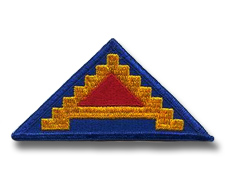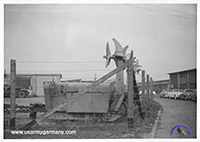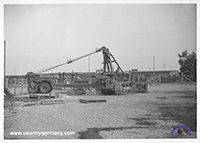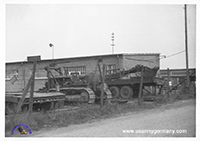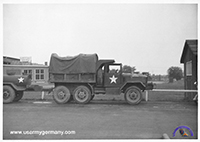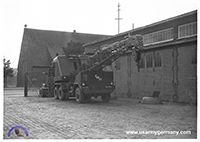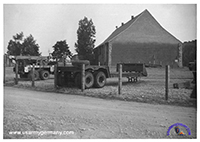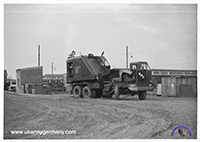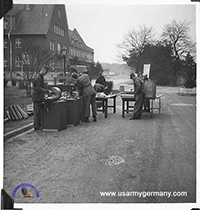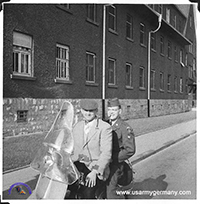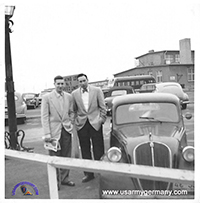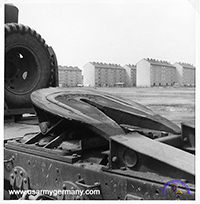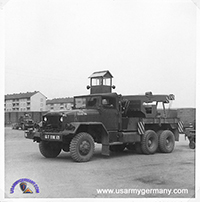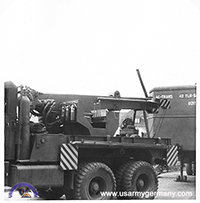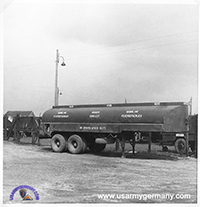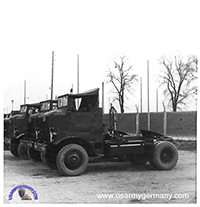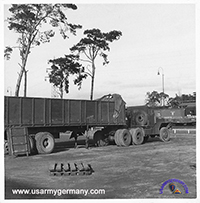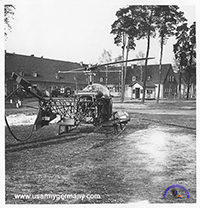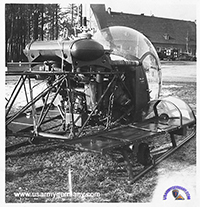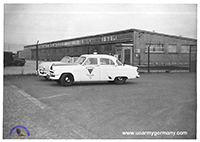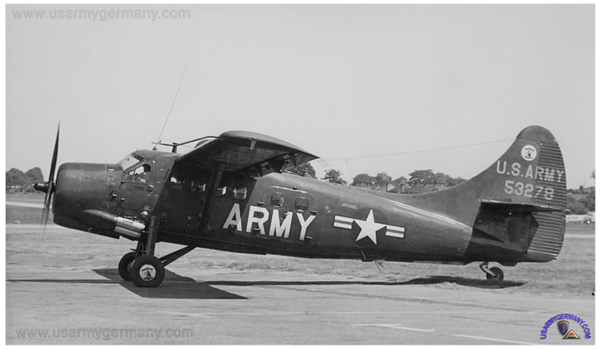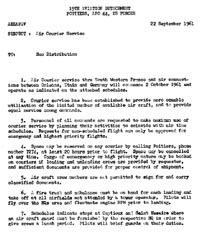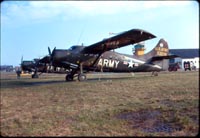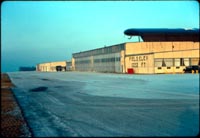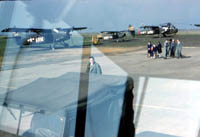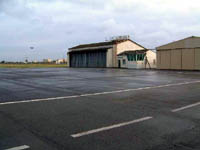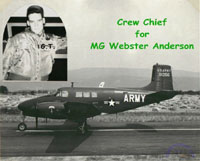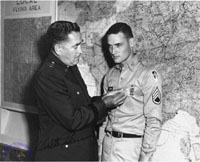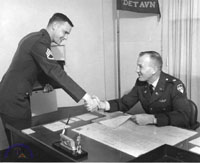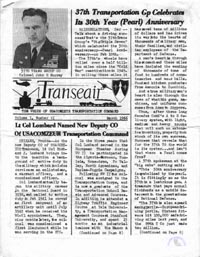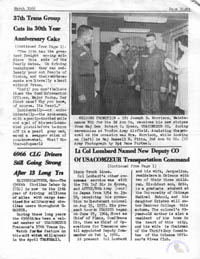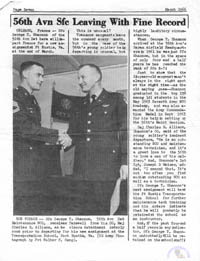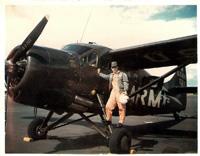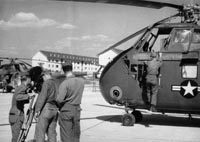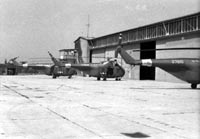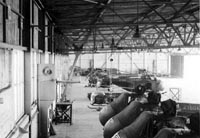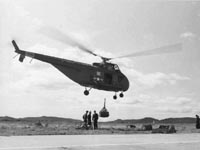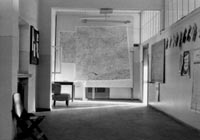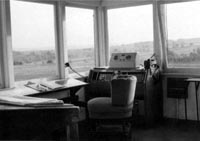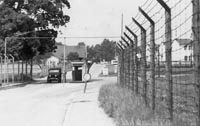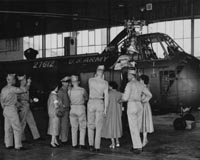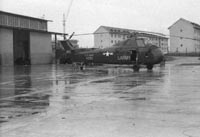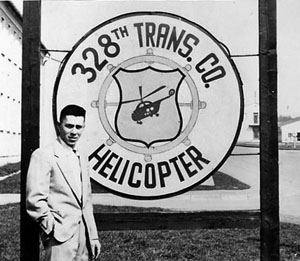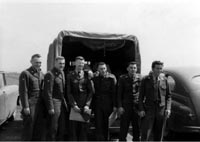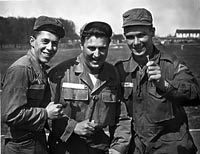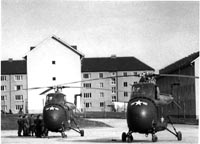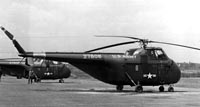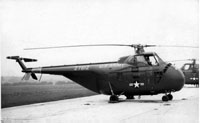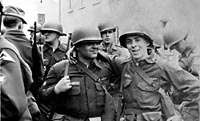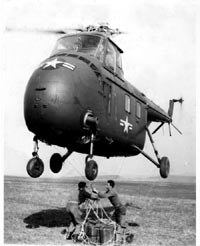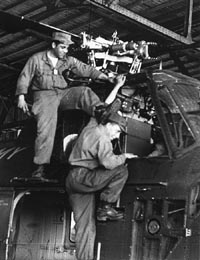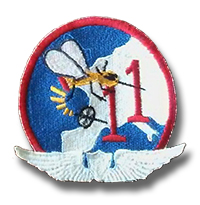| If you do
NOT see the Table of Contents frame to the left of this page, then
Click here to open 'USArmyGermany' frameset |
||||||||||||||||||||||||||
8th Transportation Group (Movement Control) |
||||||||||||||||||||||||||
|
|
||||||||||||||||||||||||||
|
||||||||||||||||||||||||||
|
|
||||||||||||||||||||||||||
| Group History | ||||||||||||||||||||||||||
| 1949 - 1963 | ||||||||||||||||||||||||||
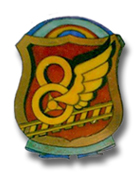 8th Trans Gp Insignia early 1950s 8th Trans Gp Insignia early 1950s 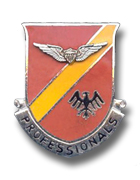 8th Trans Gp DI 8th Trans Gp DI |
||||||||||||||||||||||||||
| The 8th Transportation
Brigade was originally constituted on 9 December 1943 as the 8th
Traffic Regulation Group. The unit was trained at Fort
Lawton, Washington, prior to serving in the European Theater in World
War II in the Northern France and Rhineland Campaigns. In June 1946,
the unit was inactivated at Reims, France, and later reactivated at
Frankfurt, Germany, in October 1949. Allotted to the Regular Army on 27 March 1951, the designation 8th Transportation Group was given to the unit on 3 January 1955. The Group served in Germany until deactivation in December 1963. |
||||||||||||||||||||||||||
| If you have more
information on the history or organization of the 8th Transportation
Group, please contact me |
||||||||||||||||||||||||||
|
|
||||||||||||||||||||||||||
| 8th Transportation Traffic Regulation Group | ||||||||||||||||||||||||||
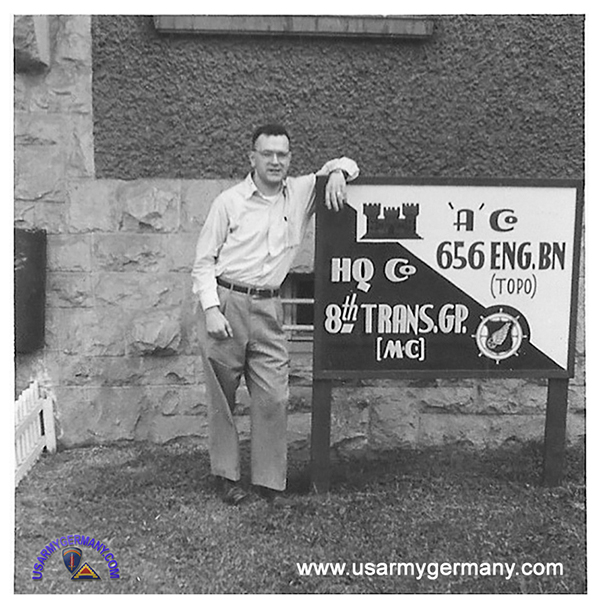 |
||||||||||||||||||||||||||
| 1952 | ||||||||||||||||||||||||||
| (Source: STATION LIST, 15 December 1952) | ||||||||||||||||||||||||||
| Organization of the 8th Trans Traffic Reg Gp in December 1952: | ||||||||||||||||||||||||||
|
||||||||||||||||||||||||||
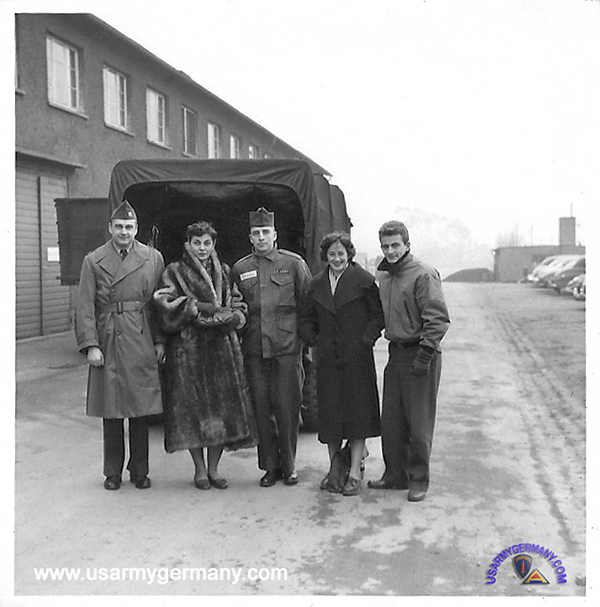 Members of the 8th TTRG at Tompkins Barracks (Daniel Richetts) L to R: Capt Lewis Stouffer; Ms. Marliese Roth; Sgt John Frizzel; Ms. Trudy Benz; and Brand |
||||||||||||||||||||||||||
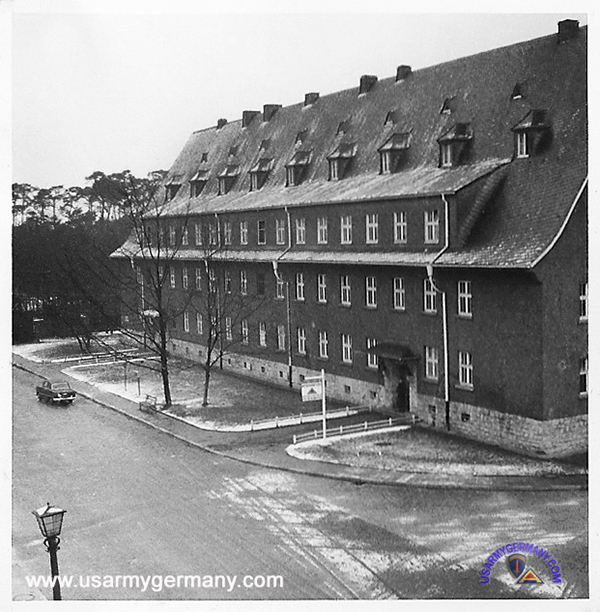 The Labor Service Company building (Bldg 4222) (Daniel Richetts) |
||||||||||||||||||||||||||
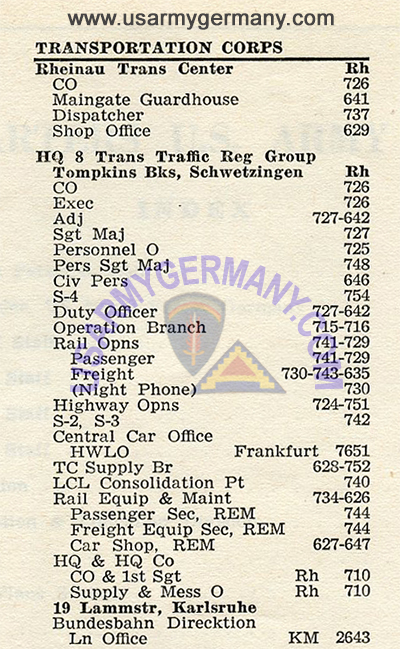 8th TTRG, Schwetzingen, Nov 1953 (Webmaster's collection) |
||||||||||||||||||||||||||
| 1953 | ||||||||||||||||||||||||||
| (Source: STARS & STRIPES, Dec 31, 1953) | ||||||||||||||||||||||||||
| The Kaiserslautern Movement Control Office (MCO) at Roux (Panzer) Kaserne, Kaiserslautern, is an element of Company D, 8th Trans Traffic Regulating Gp. The MCO is responsible for regulating the movement of military supplies and personnel over the highways and railroads in Western Area Command. Established in January 1952, the MCO consists of seven officers and 33 enlisted men. Its administrative offices were initially located in midtown Kaiserslautern, but just recently have been moved to Kleber Kaserne. The unit maintains close liaison with all shipping and receiving agencies, effecting great savings for the US by proper vehicular utilization and by keeping close watch over demurrage costs. The MCO acts as an agent between the German railroads and the using organizations. In addition, it maintains liaison in all matters pertaining to repairs and rehabilitation of all Bundesbahn equipment furnished to the US forces. Keeping an around-the-clock check on traffic density and road conditions, the MCO regulates any highway move involving five or more military vehicles traveling together. These are considered convoys, and must be cleared by the MCO. When the vehicles are ready to roll, the MCO assigns them a release number and gives them a prescribed route. A large percentage of the passenger moves handled by the Kaiserslautern MCO originates at the replacement depot in Zweibruecken. |
||||||||||||||||||||||||||
| 1954 | ||||||||||||||||||||||||||
| (Source: Email from Daniel Richetts, son of Don Richetts who served with the 8th TTRG in Schwetzingen) | ||||||||||||||||||||||||||
| I'm writing in response to your request to hear from people with information about the 8th Transportation Group. My father, Don J. Richetts, served on Tompkins Barracks, Schweitzingen, Germany, as a Movement Specialist with Headquarters and Headquarters Company, 8th Transportation Group (1954-1955). Several years ago he gave me a photo album with several photos showing his unit conducting training, as well as photos on and around Tompkins Barracks. If you are interested in these photos I will scan and email them to you. Click here to view additional photos submitted by Daniel Richetts of the Rheinau Transportation Center. |
||||||||||||||||||||||||||
| (Source: STARS & STRIPES, May 24, 1954) | ||||||||||||||||||||||||||
| Ten trains and 22 motor convoys were put on the "road" without a hitch by Company B of the the 8th Trans Traffic Regulation Gp, following a recent training exercise by the 5th Div. Under the direction of Capt R. R. Myers, Sfc William L. Gaitens and Cpl Alfred E. J. Kelly drew up schedules so that no time was wasted during the movement. The 5th MP Co handled the job of control. Co B, which acted as liaison between Division G4 and the German Federal Railways, is stationed at Nurnberg. It covers the area from Wuerzburg to Regensburg. Any difficulties arising from last minute cancellations are quickly handled by Myers and his assistants. In case of a major breakdown, the company had alternate routes to reconsign or divert convoys or shipments. |
||||||||||||||||||||||||||
| "Stadt Koeln" Yacht (PHI-1) | ||||||||||||||||||||||||||
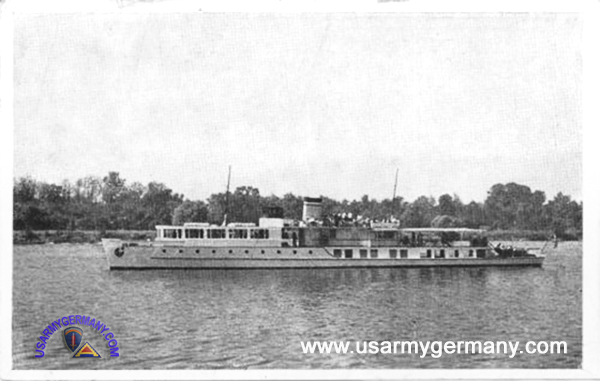 A US Army post card from the late 1940s showing "Hitler's Yacht" on an excursion along the Rhine River with US military personnel and friends |
||||||||||||||||||||||||||
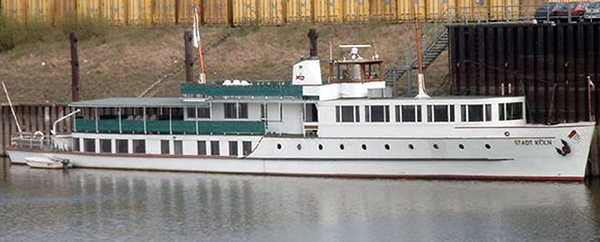 A more recent photo of the "Stadt Köln" (Archiv Klaus F. Krüger, CC) |
||||||||||||||||||||||||||
| 1951 | ||||||||||||||||||||||||||
| (Source: STARS & STRIPES, July 22, 1951) | ||||||||||||||||||||||||||
| In the "Memo for Newcomers" section of the S&S issue, a brief article appeared about the vessel: "Cruising on the Rhine is a popular summer pastime among EUCOM personnel. Available for large parties is the famous Stadt Koln or City of Cologne, better known as Hitler's Yacht. This ship is not to be confused with another Hitler yacht — the Grille — a 2,500-ton ship which became the property of the North American Smelting Co., and was turned into scrap at a N. J. junk yard this year. The City of Cologne is used for official purposes as well as cruises, which are governed by EUCOM regulations and for which a charge of $100 per trip is made. The policies and procedures governing use of the yacht were outlined recently in a EUCOM Hq directive. This stated that when not required for official use, the ship would be made available to any organization for recreational purposes. The yacht can be operated between the hours of 10 am and 8 pm, and must leave and return either to Mannheim or to Biebrich. Priority is given to organizations requesting its use in groups of 75 persons or more. Bookings are not accepted more than 60 days in advance, nor can they be made for organizations with total personnel strength of less than 100. Requests for bookings should be made to EUCOM Hq, attention, Chief Transportation Division, listing the telephone number of responsible person, strength of organization, number of personnel to participate in trip, date and hours for reservation, desired point of departure, and point of return." |
||||||||||||||||||||||||||
| 1952 | ||||||||||||||||||||||||||
| (Source: STARS & STRIPES, Oct 3, 1952) | ||||||||||||||||||||||||||
| The 100-ton motor yacht "Stadt Koeln" was returned to German control during a brief turnover ceremony at the USAREUR Rhine River dock at Rheinau. During the ceremony, Col Harold C. Howe, CO of the 8th Transportation Traffic Regulation Gp, presented the ship's papers to Dr. Max Adenauer, son of the West German chancellor, Konrad Adenauer. Dr. Adenauer serves as the commissioner for economics and harbors at Cologne and represented the city at the ceremony. Col Howe's unit had been in charge of the yacht during the past few years. 1) The famous vessel, constructed in 1938 at a cost of $30,000, was confiscated by the US Army in March 1945 and was used by Special Services for the past 7 1/2 years, carrying Americans on outings, cruises and other special trips along the Rhein River. 1) According to an article on the German Wikipedia website, the vessel was redesignated as PHI 1 during its tenure as an Army TC vessel. |
||||||||||||||||||||||||||
| 8th Transportation Group (Movement Control) | ||||||||||||||||||||||||||
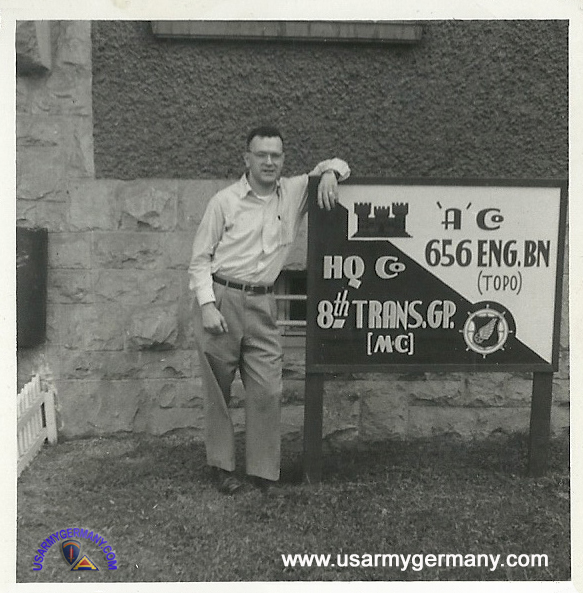 Don Richetts next to the Co A, 656th Topo Bn and Hq Co, 8th Trans Gp sign on Tompkins Barracks, mid-1950s (Daniel Richetts) |
||||||||||||||||||||||||||
| (Not yet confirmed: The 8th TTRG was redesignated as 8th Transportation Group (Movement Control) on January 3, 1955.) | ||||||||||||||||||||||||||
| 1958 | ||||||||||||||||||||||||||
| 8th Trans Gp, Ludwigsburg, is Seventh Army's only aviation group. Organization of the 8th Trans Gp in June 1958: |
||||||||||||||||||||||||||
|
||||||||||||||||||||||||||
| MISCELLANEOUS
UNIT INFORMATION The Stuttgart Sub Area Telephone Directory for March 1957, shows that the 8th Trans Gp (MC) is stationed in Ludwigsburg. It also indicates that one of its subordinate elements is the 7th US Army Command Train Detachment which is also stationed at the same post (Flak Kaserne?). Does anyone have some information on that? |
||||||||||||||||||||||||||
|
|
||||||||||||||||||||||||||
| 2nd Aviation Company (Army)(Fixed Wing Tac Trans) | ||||||||||||||||||||||||||
| 1958 - 19.. | ||||||||||||||||||||||||||
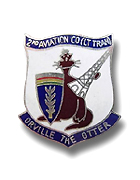 2nd Avn Co (Army)(FWTT) DUI
2nd Avn Co (Army)(FWTT) DUI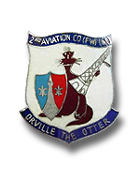 2nd Avn Co (Army)(FWTT) DUI
2nd Avn Co (Army)(FWTT) DUI |
||||||||||||||||||||||||||
|
The 2nd
Avn Co (Army)(FWTT) arrived in Europe in 1958, attached
to the 8th TC Group (MC) and stationed at Illesheim, Germany. At it's peak the 2nd had the headquarters, service and a fixed wing platoons in Verdun with a platoon in Orleans. A section of the Orleans platoon operated out of Poitiers. Operational missions covered all of Europe. From Spain, to England to Italy, to Scotland, Turkey, Greece, Belgium, France, and Sweden. |
||||||||||||||||||||||||||
|
|
||||||||||||||||||||||||||
| (Source: Army Aviation Battlefield Mobility, Army Information Digest, August 1958) | ||||||||||||||||||||||||||
| Fixed Wing Tactical Transportation Company - companies were equipped with 16 U-1A "Otter" fixed-wing aircraft. These companies were capable of transporting approximately half of an infantry company for about 300 miles. Webmaster Note: According to information found while doing research on the U-1A Otter, at least some if not all of the Otters flown by the 2nd Avn Co in France were transferred to the 56th Aviation Detachment, stationed at Coleman Barracks, Mannheim-Sandhofen. This unit was the last unit to fly Otters in Europe, until 1971. The Otters were eventually sold on the civilian market. |
||||||||||||||||||||||||||
| If you have more information on the history or organization of the 2nd Avn Co (Army)(FWTT), please contact me. | ||||||||||||||||||||||||||
| (Source: Hanno Englaender) | ||||||||||||||||||||||||||
| The only pure Otter units in Europe were the 2nd and 3rd Aviation Companies (FWTT). Both units were deployed to West Germany in April and May of 1957 (?) and were initially stationed at Illesheim Army Airfield, approximately 60 kilometers west of Nürnberg. In July of 1959 the 2nd Avn Co was moved to France and split into three different locations. They were: The 2nd was eventually disbanded in 1965 and the unit was redesignated and sent to Vietnam. |
||||||||||||||||||||||||||
(Source: Email from Devon L Nooner) |
||||||||||||||||||||||||||
Upon completion of Fixed Wing Qualification at Ft Rucker, Alabama, also known as Mother Rucker because it was the Home of US Army Aviation, I was assigned to the 3rd Trans Co (H-21). I was also assigned to the Executive Flight Detachment for duty as Pilot and Co-pilot status for transportation requirements for the President of the United States and his staff.
I received orders assigning me to the 4th Logistical Command (COMZ) located at Verdun, France with duty at Verdun Army Airfield. Reporting for duty on or about 10 July 1961. My immediate commander was Col Grothaus, who was later promoted to B/Gen and replaced by B/Gen F.J.Chesarek. The Transportation Officer for the 4th Log Cmd, who oversaw operations at Verdun Army Airfield, was Col Charles A. Leavitt. The 4th Log Cmd had four (4) aircraft assigned and were stationed at Verdun Army Airfield -- H-13G, L-19A, L-20A and a U-8D. The other 2 units that were stationed at VAAF were the 2d Aviation Company (Fixed Wing Light Transport, U1A) and the 26th Aviation Company (Light Helicopter, H-34). Upon reporting for duty to the Airfield Commander, Major Leslie H. Gilbert, I was informed that I would also be given a check-out in the L-20A Beaver and also be given an instrument rating. Most of my instruction and qualification would come from other officer's assigned to the 4th Log Cmd and on occassions I would serve as Co-pilot on missions assigned to the 2d Avn Co. Upon completion of getting a check-out in the L-20A Beaver and receiving an instrument rating qualification, I was assigned to the 2d Aviation Company (FWLT) in the spring of 1963. Upon reporting for duty to the Commanding Officer, Capt Cromwell, I was introduced to the other pilots of the 2d Avn Co. Since I was not qualified in the Otter, U1A, I was immediately assigned an Instructor Pilot, CW4 Lenord G Sims, who would also give me further instructions on Instrument Flight Conditions associated with the U1A Otter. Approximately 6 weeks later I was signed off as fully qualified in the U1A Otter and performed missions to all parts of France, England, Spain, Germany and Italy as Pilot in Command. I have kept all orders of assigned personnel to the 2d Avn Co to including Enlisted Personnel at the 3 Platoons stationed in France till July 1965. My assignment after departing the 2d Avn Co was to Vietnam. I have had numerous close calls in both VFR (Visual Flight Rules) and IFR (Instrument Flight Rules) in the reliable Otter but due to the forgiveness of the mighty Otter I recovered without any damage to either myself or the Otter. What a reliable aircraft I had the fortune of flying for over 1000 plus hours with some of the finest pilots in Army Aviation. |
||||||||||||||||||||||||||
| 1961 | ||||||||||||||||||||||||||
| (Sourrce: Email from RC Neeb Jr) | ||||||||||||||||||||||||||
|
||||||||||||||||||||||||||
|
||||||||||||||||||||||||||
|
|
||||||||||||||||||||||||||
| (Source: Email from George Shannon, 56th Avn Det, 1964-67) | ||||||||||||||||||||||||||
I was assigned to the 2nd Avn Co when the company was stationed at Saran Army Airfield, Orleans France. I was actually assigned to the 2nd from about late 1960 until 1961.
Sometime in 1961, I think it was, I was transferred to the 56th Aviation Detachment, Saran Army Airfield. The 56th was attached to the 2nd Avn Co. The two outfits shared the same company area and worked, lived, and played together. It was like one organization, except the 2nd Avn personnel worked on U-1A Otters and the 56th personnel worked on U-6, U-8 D & F (old designation L-23), H-13, and later on CH-34 and UH-1. The 56th Aviation Detachment provided support to Communication Zone Europe VIPs and to aviators in the area assigned to ground duty. The 4 each U-8s, 2 each CH-34s, & one each UH-1 aircraft all were equipped with VIP packages. Sometime around 1964 the 2nd Aviation Company was transferred to Verdun, France and the 56th Avn Det became a stand-alone Avn Detachment continuing to provide the same support. I served in the 56th as a U-8 crew chief as an SP-5, then was chief of quality as a SSgt, then sometime about 1965 I was promoted to SFC and took over as Chief of Maintenance. I rotated back to the States in April 1966. At that time, the 56th was still in France at the Saran Army Airfield. I understand that not to long after that the 56th Aviation Detachment was transferred to Germany. I have include some Pics of my days in the 56th. One is when I was crewing a U-8, one is receiving the Army Commendation Award from MG Webster Anderson, COMZEUR Cdr, and one is when I was leaving France saying good bye to Maj Charles Alison, 56th Detachment Cdr. |
||||||||||||||||||||||||||
|
||||||||||||||||||||||||||
| 1964 | ||||||||||||||||||||||||||
| (Source: Email from Gary Edwards, 2nd Avn Co, 1964-67) | ||||||||||||||||||||||||||
|
||||||||||||||||||||||||||
|
All of our aircraft were transfered to the 56th and I don't know what happened after I left. When I was with the 2nd Avn, we flew missions all over Europe. It took quite a few hours flying, but I have seen a lot of Europe. We flew a lot of missions to Greece and Turkey, and a lot of support missions to Scotland and England. Those were the good old days. While I was living in France I was in the Army Reserve and did a two week tour each year. I was assigned to the 207th Avn Co in Heidleberg and stayed with them for 13 years. This was a company that was in charge of transporting all the VIPs that came to Germany. We had mostly all Beach Craft, Hueys and later on Blackhawks. At first we did all the maintenance on the Beech Craft and later on the Army bought the aircraft with maintenance contracts. |
||||||||||||||||||||||||||
| 1966 | ||||||||||||||||||||||||||
| (Source: STARS & STRIPES, March 20, 1966) | ||||||||||||||||||||||||||
Sturdy Orville May Never Make Major |
||||||||||||||||||||||||||
|
|
||||||||||||||||||||||||||
| 3rd Aviation Company (Army)(Fixed Wing Tac Trans) | ||||||||||||||||||||||||||
| 1957 - 1959 | ||||||||||||||||||||||||||
| (Source: Hanno Englaender; photo by John Riccardi) | ||||||||||||||||||||||||||
|
||||||||||||||||||||||||||
| (Source: STARS & STRIPES, July 29, 1957) | ||||||||||||||||||||||||||
| 3rd Army Avn Co and its 21 U-1A OTTER aircraft arrived in Bremerhaven in July 1957 on board the aircraft carrier Tripoli. CO of the 3rd is Maj Ralph Q. Bennett. After the Tripoli was docked at Bremerhaven, the U-1A's were unloaded and towed to the Staging Area. Strength of the company is 45 pilots, 1 warrant officer and 61 enlisted men. |
||||||||||||||||||||||||||
| (Source: My notes while doing research years ago; original source unknown) | ||||||||||||||||||||||||||
| The Company was inactivated in November 1959. | ||||||||||||||||||||||||||
|
|
||||||||||||||||||||||||||
| 11th Transportation Company (Lt Hel) | ||||||||||||||||||||||||||
| 328th Transportation Company (Hel) | ||||||||||||||||||||||||||
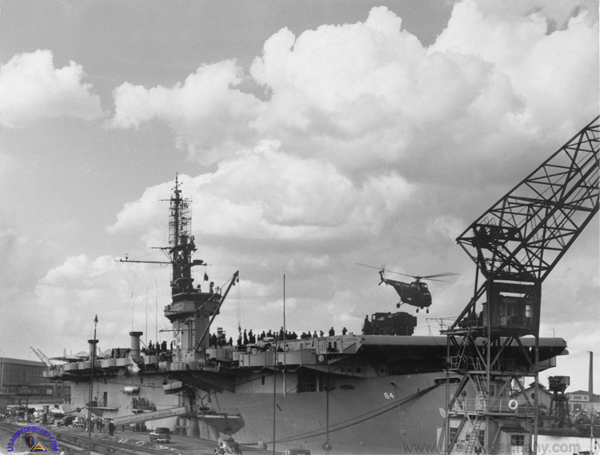 USS Tripoli, docked at Bremerhaven, delivers the H-19's of the 328th Trans Co, April 1954 |
||||||||||||||||||||||||||
| 1954 - 1956 | ||||||||||||||||||||||||||
| (Source: STARS & STRIPES, Feb 10, 1955) | ||||||||||||||||||||||||||
| The 328th Transportation Company arrived in Germany in April 1954. With a complement of 34 officers and 94 enlisted men and 21 Sikorsky H-19 helicopters, the unit was transported on the aircraft carrier, USS Tripoli, from the US to Bremerhaven. After docking at the German port, the helicopters were flown off the carrier to the unit's new home station at Nellingen. Since arriving in Germany, the 328th has been kept busy combat support and logistics tasks as well as mercy missions for 7th Army. Since April of last year, the company has participated in 15 field training exercises, hauled over 165,000 pounds of cargo and transported over 3,400 troops. The company with its 21 H-19 helicopters, has a capacity of transporting 168 troops and 15½-tons of cargo for a range of 25 miles. During field exercises, the unit has demonstrated that the H-19 is very effective in such operations as laying field wire, delivering emergency supplies, providing speedy transportation for assembling troops, and providing a mobile conference room for a commander and his staff while traveling to units in the field. During one field execise, WEST WIND in Oct 1954, the 328th carried out five helicopter emergency evacuations (on one occasion even saving the life of a soldier who suffered from extreme shock after a traffic accident), four major airlifts of larger troop contingents and unusually long range patrols behind enemy lines at night. Currently, several helicopters of the 328th are visiting 7th Army artillery units to demonstrate the helicopter's ability a 105-mm howitzer in a tactical situation. During serious flooding in the Passau area of Bavaria in July 1954, the unit was involved in rescue operations. The company rescued 132 persons in addition to delivering sandbags, water and food to isolated areas. The unit is supported by the 138th Trans Det (Cargo Hcptr Field Maint) which is also located at Nellingen. |
||||||||||||||||||||||||||
| (Source: Information submitted by Richard Johnson and originally sent to Hanno Englaender) | ||||||||||||||||||||||||||
| I arrived at Nellingen in February 1955 and was stationed there until November 1957. It was only a few years after the war and around the Stuttgart area there were still reminders of the war in the form of damaged buildings etc. I understand that Nellingen had been a fighter base during the war. The unit (328th Trans Co (Hcptr)?) I was assigned to had Sikorsky H-19 helicopters, later these were exchanged for the H-34. There was also a small medical detachment that had Bell H-13's with external litter pods for medical evacuation. The one thousand foot runway was designated as a heliport. The hangar was heated by steam from an old Russian steam engine boiler. The fuel was coal. This was converted later to an oil system. In the early Spring of 1962 I was stationed again at Nellingen with a Medical Evac unit (421st Med Co (AA)?). It had some of the old H-19's which later were exchanged for the Bell UH-1. I was the Technical Inspector for the unit. My tour lasted until the Summer of 1965. Again, in 1967 I was assigned to the 4th Aviation Company which had the big Sikorsky CH-37. This was my third assignment to Nellingen. There was not much growth at the base from my first tour to the last except for the surrounding civilian communities. The Stuttgart area had changed from the war torn city to a beautiful metropolis. |
||||||||||||||||||||||||||
|
||||||||||||||||||||||||||
| (Source: Email from Jordan Heiberger, 328th Trans Co) | ||||||||||||||||||||||||||
|
||||||||||||||||||||||||||
|
||||||||||||||||||||||||||
| 11th Transportation Company (Lt Hel) | ||||||||||||||||||||||||||
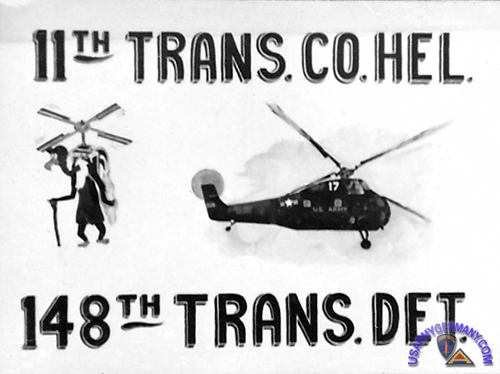 Sign at entrance to unit barracks (Jerry Pastine) |
||||||||||||||||||||||||||
| 1956 - 1966 | ||||||||||||||||||||||||||
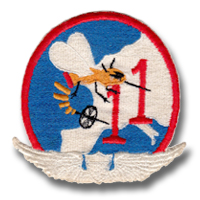 11th Trans Co
(Lt Hel) pocket patch
11th Trans Co
(Lt Hel) pocket patch |
||||||||||||||||||||||||||
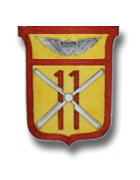 11th Trans Co (Lt Hel) crest 11th Trans Co (Lt Hel) crest |
||||||||||||||||||||||||||
| (Source: Hanno Englaender) | ||||||||||||||||||||||||||
| History The 328th Transportation Company (Hcptr) was activated at Fort Riley on 21 August 1953. Being the first Transportation Cargo Helicopter Company in USAREUR, the 328th crossed the Atlantic in May of 1954 to settle down at Nellingen, Germany. The mission was to furnish direct support to Seventh Army and NATO. On 18 May 1956, the unit was redesignated as the 11th Transportation Company (Hcptr). In keeping with the Army's constant role of training and readiness, the 11th has performed a host of diversified tasks in Europe. These activities have kept the company's big, versatile H-19s ranging over Europe from Scandinavia to the Alps. In addition to the continuous cycles of unit training which the company has maintained, they have flown VIP "load" missions, emergency rescue flights for all of Seventh Army's major units. Operating over water and all kinds of terrain, in all extremes of weather, the 11th Transportation Company (Helicopter) demonstrated in Europe the vital role of rotary-wing aircraft in the modern army although the year 1955 claimed the loss of six when two Chickasaws had an accident during a night flying exercise. During 1956, the H-19s were exchanged for the bigger and more powerful H-34A Choctaw helicopters. The later redesignation as 11th Transportation Company (Light Helicopter) reflected this change. The type was flown for about ten years before the unit was disbanded at Nellingen on June 10th 1966. |
||||||||||||||||||||||||||
|
|
||||||||||||||||||||||||||
| (Source: Email from Boyd M. Silver) | ||||||||||||||||||||||||||
|
||||||||||||||||||||||||||
| (Source: 7th Corps Support Group web site) | ||||||||||||||||||||||||||
| On 3 July 1953,
the 328th Transportation Service Company became a helicopter unit
and was redesignated as the 328th Transportation Company (Helicopter).
The unit was officially activated on 15 July 1953 at Fort Riley, Kansas.
On 18 May 1956, the unit was redesignated as the 11th Transportation Company (Helicopter). On 10 June 1966, it was inactivated in Europe. On 16 April 1986, the unit reactivated as the 11th Heavy Equipment Transportation Company at Panzer Kaserne, Stuttgart, FRG. From December 1990 through 20 May 1991, the unit deployed to Saudi Arabia in allied cooperation of the liberation of Kuwait. On 21 June 1991, the 11th Transportation Company was reassigned to the 181st Transportation Battalion of 3rd COSCOM, V Corps. In February 1992, 11th HET moved to Johnson Barracks, Furth, Germany. On 26 August 1994, 11th was reassigned to the 71st Corps Support Battalion. Effective 15 June 1995, the 11th was inactive once again. On 16 August 1998, the unit was activated once again as the 11th Heavy Equipment Transportation Company in Mannheim, Germany, and assigned to the 181st Transportation Battalion of 3rd COSCOM, V Corps. |
||||||||||||||||||||||||||
|
|
||||||||||||||||||||||||||
| (Source: STARS & STRIPES, April 3, 1957) | ||||||||||||||||||||||||||
| The 11th Trans Co took part in the recent Lion Noir CPX, a seven-day, nine-nation NATO command post exercise. With its main site collocated with Rear Command Post, 7th Army, the company's helicopters were dispersed across much of Europe. The 11th provided rotary-wing support (flying-truck and taxi servcie) to all higher levels of command, from the 34th AAA Brigade up to HQ SHAPE. Missions included troop and cargo hauls night and day. |
||||||||||||||||||||||||||
| (Source: Email from James E. Hooker, 7th Army Avn Det) | ||||||||||||||||||||||||||
| In October 1960 I was assigned to the 7th Army Aviation Detachment at Echterdingen (Stuttgart) as an instructor pilot and instrument examiner. The 11th Helicopter Company had the mission of supporting the aviation training center's mission of training pilots in instrument flight. The 11th Helicopter Company furnished at least 4 CH 34 Helicopters daily for that mission that was flown by Instructors and examiners. I left that assignment for Infantry Ground Duty in February 1962 in Munich. I do not see that particular aspect of the unit mission mentioned and it may well be beyond the scope of desired information. If so, please disregard. As an aside, we did a lot of instrument flying/training in and around a non-directional beacon (Herrenberg) just West of the Stuttgart airport. We made instrument approaches to imaginary airports and acted as our own air traffic control (without the knowledge of Stuttgart ATC). There was no radar at Stuttgart at that time. I realize that this diatribe has little to do with the actual history of the unit but thought that you might like to have it anyway. |
||||||||||||||||||||||||||
|
|
||||||||||||||||||||||||||
| Related Links: Army Otter - Caribou Association - great web page dedicated to the pilots and mechanics who flew and supported the Army's DeHavilland Otter and Caribou aircraft. 245th TC (AAHM&S) Reunion & Info - website was created and is maintained by Johnny Broussard - great photos of the 245th in the mid 1950s and Coleman Barracks (Mannheim-Sandhofen) a few years ago during a visit to the post |
||||||||||||||||||||||||||
